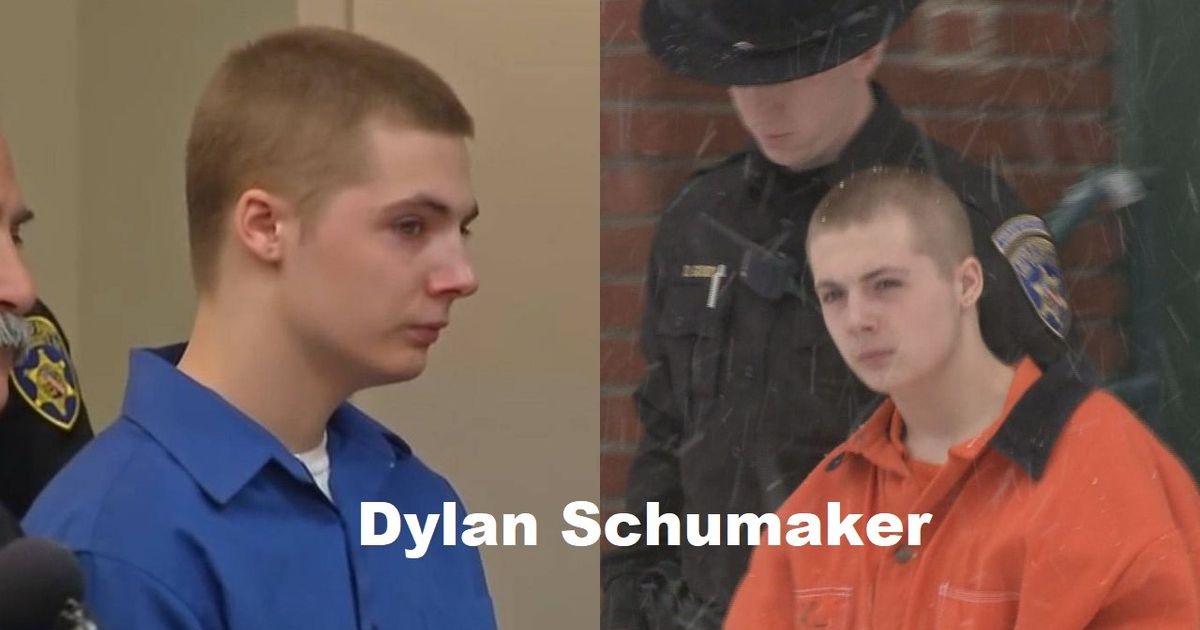The case of Dylan Schumaker, a teenager sentenced to life in prison for the brutal murder of a toddler, has sent shockwaves across the nation. At just 16 years old, Schumaker’s name became synonymous with an unfathomable act of violence that shook communities to their core. entrusted with the care of Dylan Schumaker girlfriend’s toddler Austin Smith, Schumaker’s actions on that fateful night were incomprehensible.
Reports from the scene paint a chilling picture of a young life cut short by senseless brutality. Despite the swift response of emergency services Austin’s tragic death left a community grieving and grappling with questions of how such a horrific event could occur.
Schumaker’s subsequent arrest and trial only deepened the sense of disbelief and outrage. The courtroom became a stage for heart wrenching testimonies and emotional revelations as experts attempted to unravel the psyche of a troubled teenager. While some sought to attribute Schumaker’s actions to a tumultuous upbringing marked by neglect and instability the gravity of the crime overshadowed any attempts at justification.
A Night of Tragedy
The evening began like any other, but for Dylan Schumaker and the Smith family it swiftly turned into a night of unimaginable horror. Entrusted with the care of Dylan Schumaker girlfriend’s toddler, Austin Smith, Schumaker’s responsibility took a harrowing turn as the child’s cries seemed to trigger a violent response.
What followed was a brutal attack that left Austin fatally injured, a tragedy that would haunt the community for years to come. Despite the desperate efforts of emergency responders, the night ended in heartbreak as Austin’s young life was tragically cut short.
You Might Want To Check: Bruce Wilpon Wife: Life, Career and Success

The Aftermath and Arrest
In the wake of the devastating incident, the aftermath was marked by shock, disbelief and grief. As authorities arrived on the scene, it became evident that Austin’s injuries were not accidental. Suspicion quickly fell on Schumaker whose panicked call to emergency services belied the true nature of the situation.
The subsequent arrest sent shockwaves through the community, prompting questions of how such a horrific act could occur. As the investigation unfolded, the full extent of the tragedy became painfully clear leaving a community grappling with the harsh reality of senseless violence.
Public Outcry and Trial Commencement
The public response to Austin’s death was one of outrage and demand for justice. The community rallied around the Smith family, seeking accountability for the heinous crime committed against their beloved child. As preparations for Schumaker’s trial began the courtroom became a focal point for the community’s collective grief and anger.
The trial was more than a legal proceeding; it was a reckoning with the profound loss and devastation caused by one individual’s actions. With emotions running high, the trial commenced amidst a chorus of voices demanding justice for Austin and closure for Dylan Schumaker grieving loved ones.
You May Also Like: Lola Brooke Age| Height| Birthday| Bio and Net worth

Unraveling the Psyche of Dylan Schumaker
Central to the trial was the task of unraveling the psyche of Dylan Schumaker, a troubled teenager whose actions had shattered lives. Expert testimonies and psychological evaluations delved into Schumaker’s past, revealing a complex portrait of a young man marked by emotional turmoil and instability.
The defense sought to contextualize Schumaker’s actions within the framework of Dylan Schumaker troubled upbringing, while the prosecution painted a stark picture of a cold blooded killer. As the trial progressed, the truth behind Schumaker’s motives remained elusive leaving the community to grapple with the unsettling question of what drives a person to commit such a horrific act.
Justice Served
After a lengthy and emotionally charged trial, the verdict was reached: Dylan Schumaker was found guilty of the brutal murder of Austin Smith. The sentencing, life in prison without parole, served as a stark reminder that actions have consequences, even for those as young as Schumaker.
While the verdict brought a sense of closure to some for others the pain of losing Austin will never fully heal. However, the outcome reaffirmed society’s commitment to upholding justice and holding individuals accountable for their actions regardless of their age.
Community Healing and Legislative Impact
In the aftermath of Austin’s tragic death, the community rallied together to support the Smith family and each other. Through vigils, fundraisers and acts of kindness, they found solace in coming together during a time of immense grief. Additionally, the case sparked discussions about the need for legislative changes to prevent similar tragedies in the future.
Advocates pushed for stricter laws concerning child abuse and domestic violence, emphasizing the importance of protecting the most vulnerable members of society. While the pain of loss may never fully subside, the community’s resilience and unity serve as a beacon of hope for a brighter future.
Reflections on the Legal System’s Approach
Dylan Schumaker’s trial prompted reflections on the legal system’s approach to juvenile offenders. Trying Schumaker as an adult raised ethical questions about the appropriate balance between punishment and rehabilitation for young offenders.
Some argued that Schumaker’s age and troubled upbringing warranted a more lenient approach, while others maintained that the severity of his crime demanded harsh punishment. Regardless of where one stands on the issue, Schumaker’s trial serves as a reminder of the complexities inherent in the justice system and the need for thoughtful consideration of each case’s unique circumstances.

Understanding Violence in Youth
Schumaker’s actions forced society to confront the issue of violence in youth and its underlying causes. While his case was extreme, it shed light on the broader issue of aggression and violent tendencies among young people.
Factors such as a troubled home environment, exposure to violence and untreated mental health issues can all contribute to a propensity for violence. By addressing these root causes and providing early intervention and support, communities can work towards preventing future tragedies and fostering healthier environments for young people to thrive.
The Media’s Role in Shaping Perceptions
The intense media coverage surrounding Dylan Schumaker’s case played a significant role in shaping public perceptions and attitudes towards juvenile crime and violence. While the media serves as a crucial source of information, its portrayal of such cases can often sensationalize the details, leading to misconceptions and biases.
In Schumaker’s case, the media coverage not only informed the public about the proceedings but also sparked debates about the ethics of broadcasting a trial involving a minor. There were concerns about the potential impact on Schumaker’s right to a fair trial, as well as the privacy of those involved, particularly given the sensitive nature of the case involving a young victim.

Societal Measures for Child Safety
The tragedy surrounding Austin Smith’s death has prompted a critical examination of societal measures for child safety. Communities and families must work collaboratively to create safe environments for children, emphasizing the importance of proper childcare and the dire consequences of neglect.
Additionally, there is a pressing need for effective mechanisms to report and respond to signs of child abuse or neglect promptly. This includes not only legislative measures to strengthen protections for children but also education and awareness campaigns to empower individuals to recognize and address issues of child safety. By prioritizing the well being of children and implementing robust measures for their protection, society can strive towards creating a safer and more nurturing environment for future generations.
Frequently Asked Question
How did the community react to Dylan Schumaker’s sentencing?
The community was shocked and appalled by the horrific nature of the crime. There was an overwhelming sense of sympathy and support for the victim’s family, along with a demand for justice to be served.
Was there any indication of a motive behind Dylan Schumaker’s actions?
While the exact motive remains unclear, reports suggest that Schumaker may have reacted violently to the toddler’s crying. However, the specifics of his motive were a point of contention during the trial.
How was the legal system’s approach to trying Dylan Schumaker affected by his status as a teenager?
Despite his age, Dylan Schumaker was tried as an adult due to the severity of the crime. The prosecution argued that the brutality of the murder warranted adult charges and consequences.
What measures were taken by the community and legislative bodies following Austin Smith’s tragic death?
Austin Smith’s death prompted a reevaluation of legislative measures concerning child safety and domestic violence. Community leaders, activists and lawmakers collaborated to advocate for stricter laws to protect vulnerable children and prevent similar tragedies.
What broader discussions has Dylan Schumaker’s case sparked regarding juvenile crime and violence prevention?
Schumaker’s case has ignited discussions about the root causes of juvenile crime and the balance between rehabilitation and punishment for young offenders. It has also highlighted the importance of early intervention and support for at risk youth to prevent future instances of violence.
Conclusion
In conclusion, the case of Dylan Schumaker, a teenager sentenced to life in prison for the brutal murder of a toddler, serves as a harrowing reminder of the devastating consequences of unchecked violence and the fragility of innocence. The tragedy surrounding Austin Smith’s death sparked a wave of shock, grief and outrage within the community, prompting a collective demand for justice and accountability.
While Schumaker’s sentencing may provide some semblance of closure for the victim’s family and the community at large, it also raises poignant questions about the complexities of juvenile crime, the efficacy of the legal system and the imperative of addressing the root causes of violence among youth. As society grapples with the aftermath of this heartbreaking case, it is incumbent upon us to work towards fostering safer, more nurturing environments for our children and to strive for a future where such senseless tragedies are but a distant memory.

“Amelia Carrington, a seasoned humorist with 8 years in the ‘puns jokes’ domain, crafts laughter through witty wordplay and clever humor.











